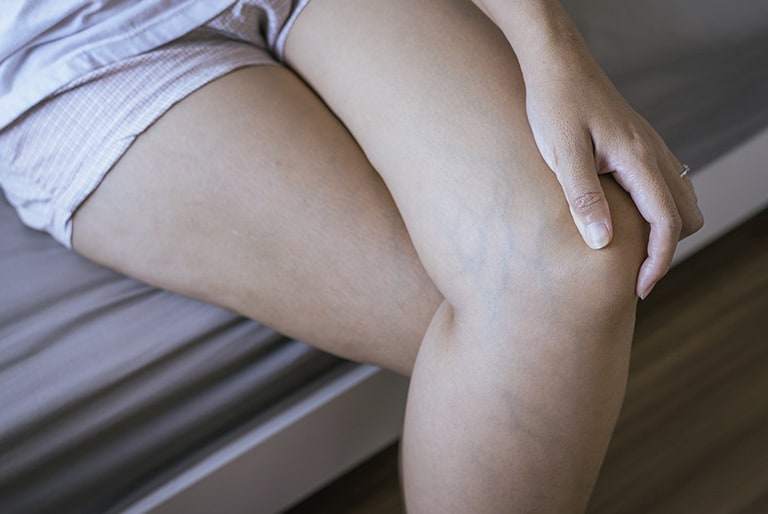How do you recognise varicose veins?
Do varicose veins cause symptoms and are spider veins already small varicose veins? Many people know the condition of the unattractive vein expansions, but do not really know if they are themselves afflicted. Here you can learn how to recognise the first signs of varicose veins and what you can do against them.

How do you notice that you have varicose veins?
Varicose vein disease (varicosis) is a diseased enlargement of the superficial veins, which predominantly appears on your legs. These varices, as they are also called, are enlarged blood vessels which are usually visible through the skin, and are frequently the consequences of an already existing weakness of the connective tissue, often accompanied by venous insufficiency. The following can be forerunners or indications of varicose veins:
- Heavy legs
- Swollen legs
- Painful legs
- Feeling of tightness in the legs
- Tingling in the legs
- Nightly calf cramps
- Spider veins
- Brownish discolouration of the skin
The symptoms frequently get worse in heat or as the day progresses, as prolonged standing or sitting in the office causes more and more blood which can no longer be forwarded upwards to pool in your veins. In addition, water in the legs accumulates because removal via the lymphatic channels also falters.
In most cases, the varices stand out clearly before any bodily symptoms emerge. That is why many people afflicted see varicosis as an aesthetic problem rather than recognising the health risk.
What do varicose veins look like?
Since varicose veins lie directly under the skin, they are usually clearly visible from outside. The protruding veins can take various forms and look different with every varicose vein patient:
- Sometimes the veins twist along the whole leg.
- Sometimes the varicose veins appear knot-like.
- The varicose veins are reddish or bluish.
- Often it is your feet or lower legs with are affected – but varicose veins can appear anywhere on your legs.
- Sometimes the varices appear more strongly on your ankles and in the hollow of your knees.
- Varicose veins of the perforator veins often form on the inside of the leg above your knee or above your ankle.
- Varicose veins of the lateral branch veins are usually extremely tortuous and bulge out strongly under the surface of the skin.
- Varicose veins of the trunk veins are on the other hand hardly visible from outside, but usually appear with lateral branch varices.
The size of the varicose veins is not connected with the severity of the symptoms. Some people afflicted have very pronounced varices, but hardly feel impaired by them. With other people, the varicose veins are only slightly visible, but their legs feel heavy and are painful.
Are varicose veins always visible?
What causes varicose veins?
Varices are the result of chronic venous insufficiency; that is a permanently existing vein weakness, which often appears in conjunction with weak connective tissue. Veins and tissue are not strong enough in the long run to effectively pump the volume of blood upwards towards the heart. In addition to that, the venous valves no longer seal and allow blood to fall back down. The vein walls expand due to the pressure of the accumulated fluid and with time visibly protrude.
The predisposition for connective tissue weakness is in most cases inherited and can only be marginally influenced. As hormonal changes are also one of the causes, women in particular often suffer from varicose veins, which sometimes suddenly appear during pregnancy. Age is also a risk factor, which cannot be prevented.
What is more, spider veins are a pre-stage of varicose veins and therefore should not be dismissed as a mere beauty flaw.
How can I prevent varicose veins?
Exercise is the best therapy for preventing varicose veins. Sport and strolls should be a daily occurrence even in younger years because varicose veins are not only a problem of people with advanced age. Women are particularly affected due to hormonal changes. That is why the following are important: strengthening veins from early on is the best prevention against varicose veins.
Vein training in the form of gymnastics and contrast showers encourages the functionality and elasticity of your veins. In addition to that, your blood needs sufficient fluids in order to be able to flow unhindered through your vessels. In short, a healthy way of living including a vitamin-rich diet is the basis for effective veins.Furthermore, the fluidity of your blood can be improved with medicines such as Veno SL® 300. If a genetic predisposition is known, it can help to wear compression stockings as a precaution.